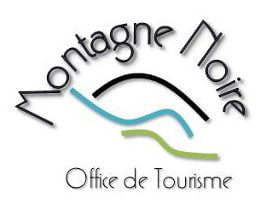
The Montagne Noire, its lakes and hiking trails
The Montagne Noire in Aude
Located in south-west France, the Montagne Noire is a mountainous region in the Aude department of the Occitanie region. This region is characterized by its spectacular natural scenery, rich history and unique culture. From your campsite near Carcassonne, in Brousse et Villaret, go hiking in the Montagne Noire (Black Mountain)
Montagne Noire takes its name from the color of the fir forest that covers its mountains. The region is also home to numerous lakes, streams, waterfalls, caves and caverns, attracting large numbers of visitors every year in search of nature and tranquillity.
Known for its rich historical heritage, it has been inhabited by man since prehistoric times, and many traces of this presence are still visible today. The region was once a center of iron ore and coal production, and many towns and villages were built around these activities. Today, the old mines and associated buildings can still be seen, testifying to the importance of this industry in the region’s history.
The Montagne Noire is also famous for its churches and abbeys. Villelongue Abbey, founded in the 12th century, is one of the region’s most visited sites. This Benedictine abbey is a remarkable example of Romanesque architecture, with its facade adorned with sculptures and capitals.
The Montagne Noire, a hiker’s paradise
The Montagne Noire is also a prime destination for outdoor sports enthusiasts. Hiking is very popular in the area, with many marked trails offering spectacular views of the mountains and valley below. The region’s lakes also offer numerous opportunities for water sports, including swimming, fishing and sailing.
- Signposted walks starting from the campsite. The Brousses et Villaret ETP association has invested a great deal of time and effort in creating, marking out and maintaining hiking trails and paths from the village to discover the local flora and fauna.
For more information: http: //associationetp11.e-monsite.com/pages/sentiers-de-randonnees/
- Other walks in the Montagne Noire: 17 circuits are listed on the Montagne Noire tourism website for walks in a wild and abundant nature offering magnificent landscapes.
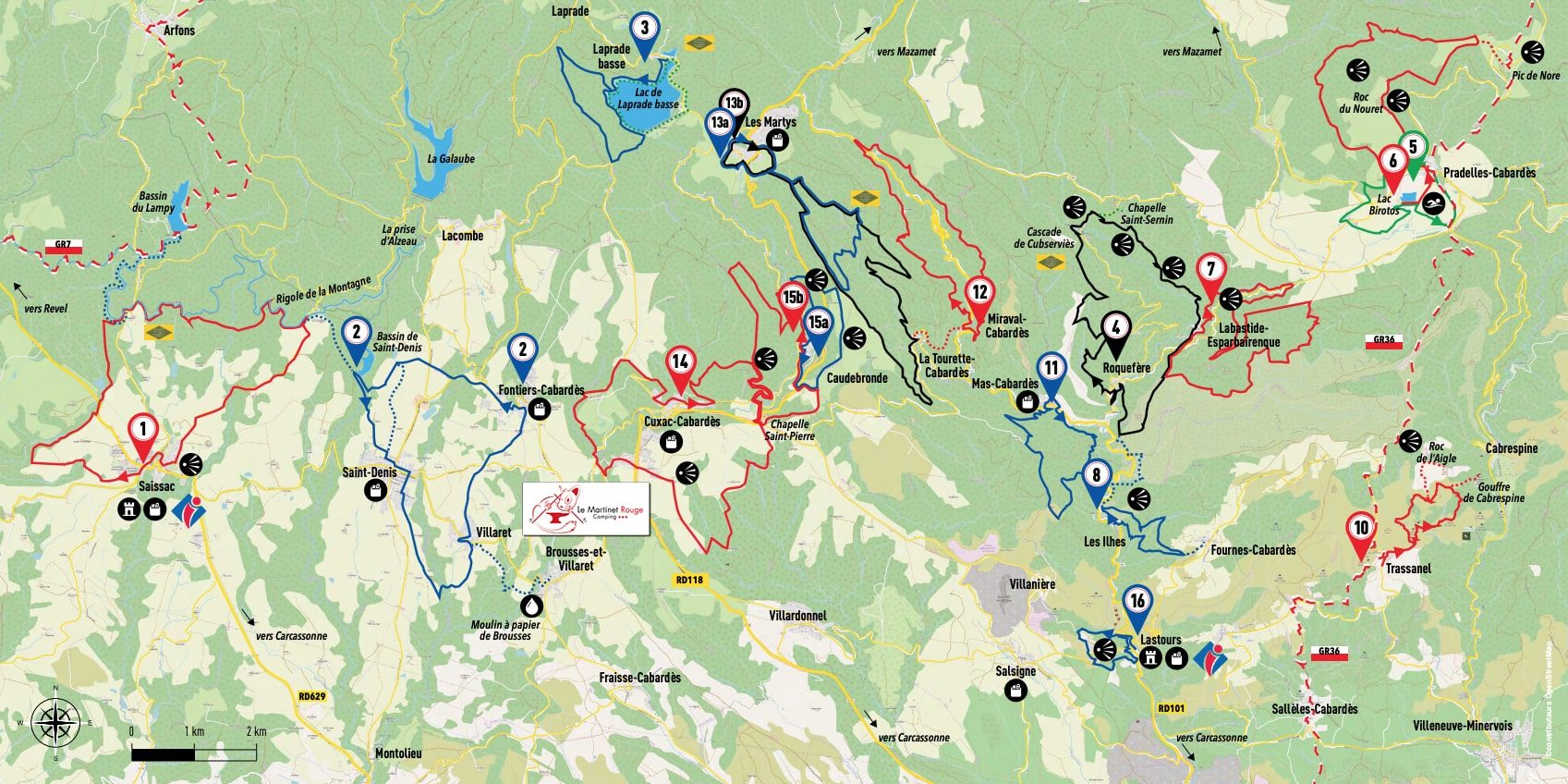
Visit the Montagne Noire tourism website: http: //www.tourisme-montagnenoire.com/profiter/randonnees-en-montagne-noire
The Montagne Noire, its lakes and waterways
- Lac de Laprade in Cuxac Cabardès: walking, fishing and horse-riding on the banks of this1st category lake.
- Lac du Lampy at Saissac: a peaceful, shady lake, ideal for walks, close to the Rigole de la Montagne Noire, source of the Canal du Midi. Kayaking is also available. Authorized bathing is supervised in summer.
- Bassin de Saint Denis, just 4 km from the campsite, has trails easily accessible to the whole family, relaxing scenery and picnic tables. Swimming is not permitted, but this lake is very popular with local fishermen (1st category water body).
- The Saint Ferréol basin near Revel: a Unesco World Heritage site, it is a water reserve for the Canal du Midi. Its museum retraces the history of the project by Pierre Paul Riquet, inventor of the Canal du Midi. A real leisure center, you can stroll, eat and even take part in a wide range of activities (beaches, pedal boats, fishing, horse-riding, etc.). Supervised swimming in summer.
- Lac des Cammazes: ideal for hikers and mountain bikers, this site is surrounded by lush greenery. For fishing enthusiasts, this lake is teeming with pike, pike-perch, perch, chub and brown trout!
- Lac des Montagnès: near Mazamet, a water sports base with inflatable games, beach, restaurants, etc.
- The Cubserviès waterfall
Book your accommodation near Montagne Noire now
Book your pitch near Montagne Noire
Camping in Montagne Noire, Montagne Noire hiking in Aude
Le Martinet Rouge campsite is ideally located for hiking in the surrounding woods and garrigue in the Aude department. They are accessible to all, with varying degrees of difficulty depending on the distance, but all allow you to enjoy the wonderful landscapes of the region around Carcassonne.
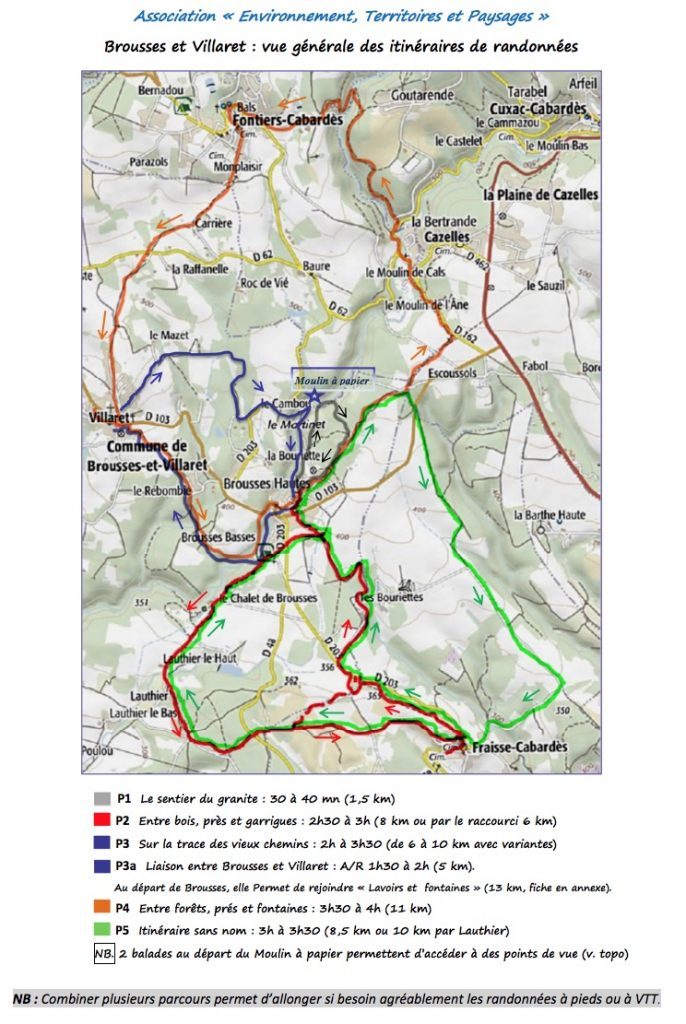
Click on the image to download the map
Hiking trails near Carcassonne in Aude around the campsite
The Granite Trail
30 to 40 minutes (1.5 km)
In and around Brousses, the traces of the nearby Montagne Noire are extended by the outcrop of rocks visible in many places
This trail takes you past the remains of the old stone quarries, which have remained untouched since they were mined. You can see cut stones and the beginnings of cracks, which in those days were widened by wooden wedges that, when wet and depending on the temperature, caused the stone to split.
Hiking through woods, meadows and garrigues
8 km (2h30 to 3h).

This walk takes you through trees and groves of various species, and offers magnificent views of the Carcassonne valley, the Pyrenees and the Montagne Noire. It’s worth noting that this hike takes you past a hundred-year-old Lebanese cedar. Last but not least, birdwatchers will be able to catch a glimpse of raptors on their walk.
Hiking on the trail of ancient paths
6 to 10 km (2h to 3h30)
This circuit is a loop linking the two villages of Brousses and Villaret, along old paths lined with old stone walls that the elders patiently built to criss-cross the countryside. The walk takes you through both villages, taking in the rural heritage (fountains, wash-houses, etc.) and the shade of tall, varied trees whose roots dip in search of water in small streams. Finally, the trail leads down to the torrent de la Dure, with the paper mill, still in operation.
Hiking through forests, meadows and fountains
11 km (3h30 to 4h)
This hike takes in the whole of Fontiers-Cabardès to the north, where you can visit the church of Saint-Clément, then Villaret and Brousses to the south, and then up to the neighbouring Moulin de l’âne and Moulin de Cal, before finishing back at the starting point. Don’t miss the rich rural heritage of the hamlets you pass through, including the dry-stone hut known as “la capitelle” by the roadside (Villaret) and the old Bringuet paper mill near the bridge at Brousses.
All these hikes can be done from your Le Martinet rouge campsite . Follow the explanations for each of them.
Thanks to the Association “Environnement, Territoires et Paysages” de l’Aude for its superb work in identifying and describing these hikes around Carcassonne in the Aude department. follow this link: http: //associationetp11.e-monsite.com/
In June, at Pentecost, go hiking in the Black Mountains
The Montagne Noire in the Aude region as you’ve never seen it before!
pentecost weekend
Take part in FESTIRANDO on June 4,5,6
and enjoy our FREE guided hikes,
departing from 5 Montagne Noire villages
(2 to 4 departures per day, tour details on flyer).
Incredible walks for all levels, breathtaking landscapes, sites rarely visited by tourists! Discover the Montagne Noire, guided by people who are passionate about their region.
You’ll be able to enjoy on-site catering, thanks to the participation of our local partners (reservations only, BEFORE JUNE).
For more information, click here:
http://www.tourisme-montagnenoire.com/
Les Martys, Saint-Denis, Fournes-Cabardès, Les Cammazes, Les Ilhes-Cabardès… Let us guide you through these surprising villages!
Breathtaking scenery and untamed nature, hikes you won’t soon forget…
Book your weekend in the Montagne Noire now!
Book your mobile home or pitch at Le Martinet Rouge and take part in the FESTIRANDO!
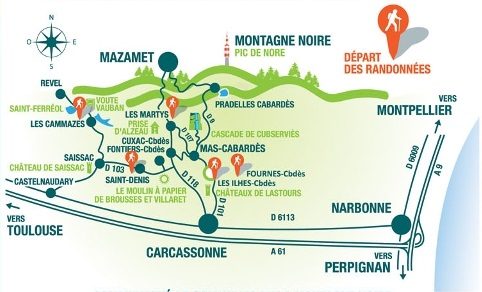
Copyright © 2016 – OFFICE INTERCOMMUNAL DE TOURISME DE LA MONTAGNE NOIRE, All rights reserved.
Photo credits ©Valérie Lafon – Pays Carcassonnais ©Christophe Bouthé – Vent d’Autan
OFFICE INTERCOMMUNAL DE TOURISME DE LA MONTAGNE NOIRE
Route de Mas-Cabardès
11380 LES ILHES-CABARDES
FRANCE
04 68 76 64 90
contact@tourisme-montagnenoire.com
www.tourisme-montagnenoire.com
camping Montagne Noire, hiking Montagne Noire
This route starts from Brousse et Villaret, where your campsite is located, and heads towards Mazamet (D103 then D118).
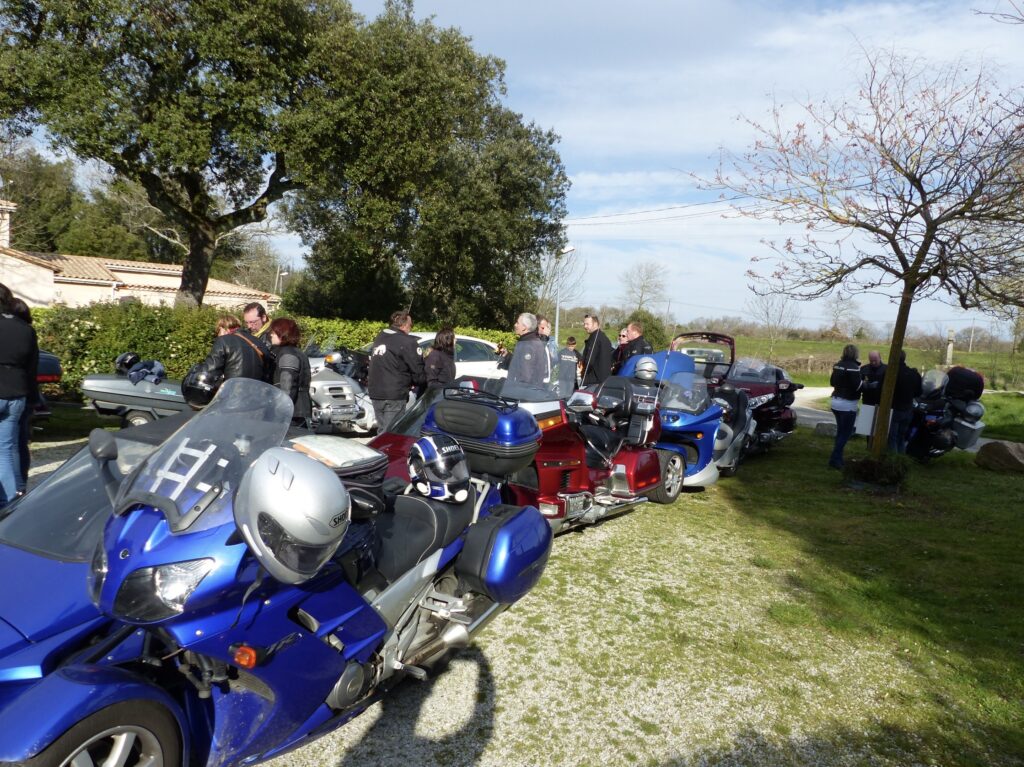
It’s a pleasant route between the mountain landscapes and the high plateaus of the Haut Languedoc Regional Nature Park. It offers cultural detours such as the Cathar town of Hautpoul, alternating between small roads in forested areas and larger ones with beautiful bends and surprises along the way, such as the Lac des Montagnès. The high point of this tour is the Pic de Nore, where you can enjoy an extraordinary panorama.
First stage MAZAMET
The town was originally founded by the inhabitants of the citadel of Hautpoul, which was devastated in 1212 during the Albigensian Crusade. The inhabitants who escaped the massacre took refuge on the banks of the Arnette – the mas d’Arnette became Mamazet. A Protestant town, it was destroyed several times during the Wars of Religion. In the 19th century, thanks to a technique developed locally, Mazamet became the world capital of délainage. Don’t miss the town’s many religious buildings, the façade of the former Banque de France, the town houses and the Prat Menhir (3.70 m).
Second stage HAUTPOUL
Just a stone’s throw from Mazamet, you’ll find the medieval town of Hautpoul, perched on a rocky outcrop that offers breathtaking views of the town and surrounding countryside from its belvederes. Visit the ancient château and Maison de le Rocque d’Hautpoul and its medieval garden. You’ll appreciate the charm of the narrow streets, with a chance to stop off at one of the many craft stores, including the Maison du Bois et du Jouet. After your visit, continue on the D87 towards the Pic du Nore.
LE PIC DE NORE
The highest point of the Black Mountain is 1211 metres high. Straddling the Aude and Tarn departments, it offers an exceptional view of the region, and an antenna has been installed at its summit.
Third stage PRADELLES-CABARDES
On the banks of the Arnette river, this small town is worth a visit to admire the Saint-Jean-Baptiste church, with its original octagonal bell tower. Another unusual visit to Pradelles-Cabardès: the semi-underground ice houses, which were in operation until 1927, used to store and sell ice cream.
Leave the D112 and take the small road to Le Mas (D9), where you’ll pass through a succession of villages: Lesjouys – Prat Viel – Labastide-Esparbairinque – Roquefer. Leave the D9 for Mas-Cabardès on the D101.
Fourth stage MAS – CABARDÈS
Originally founded in the 9th century. In the 19th century, the abbey of Saint-Étienne de Cabaret was replaced by the present-day church. In the 12th century, the farmhouse was an important ecclesiastical seigneury in the region. Today, the château is nothing but a ruin, although a few vestiges remain on the Orbiel loop. Worth seeing: Saint-Étienne church with spiral staircase and beautiful altarpiece (15th c.) – The finely-wrought weavers’ cross – Half-timbered houses – The town’s main square – The town’s main square – The town’s main square – The town’s main square – The town’s main square – The town’s main square.
Continue on the D101 to Saint-Pierre de Vals and take the D9, which will take you along the Tourette stream. Join the D73 before taking the D118 to CUXAC-CABARDÈS, a small village that was once home to the Royal Bonde cloth factory, with its dyeing and fulling facilities. The historic center shows some vestiges of this prosperous era.
Take the Route des Fontiers (D962), which takes you past the famous Brousses paper mill, and you’re back at square one, ready to recharge your batteries at your Le Martinet Rouge campsite.
The Canal du Midi
The Canal du Midi, a Renaissance
The Canal du Midi, which passes to the south of your campsite near Carcassonne, is a remarkable technical achievement for a 17th-century construction, linking the Atlantic to the Mediterranean. It’s state-owned, and after a long period of neglect, it’s been regaining its glory since 1990, when river tourism took off in a big way. Listed as a UNESCO World Heritage Site, this canal is one of the oldest in Europe.
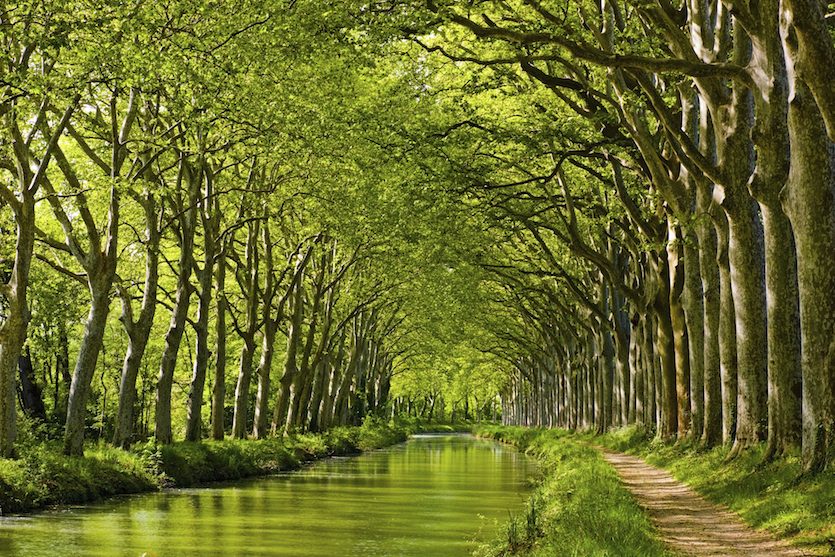
From the Atlantic Ocean to the Mediterranean Sea.
This dream became a reality thanks to the pugnacity of Pierre-Paul Riquet, the 17th-century engineer who first thought of using the tributaries flowing down from the Pyrenean mountains to feed the canal.
The Canal du Midi crosses several of Occitanie’s departments: Tarn, Haute-Garonne, Aude and Hérault.
The project was the largest of its kind in the kingdom of France, starting in 1666 and finishing in 1681, fifteen years later.
Initially, it was used to transport the kingdom’s goods, particularly wheat, avoiding the land routes along Spain, which were frequently attacked by barbarian bands.
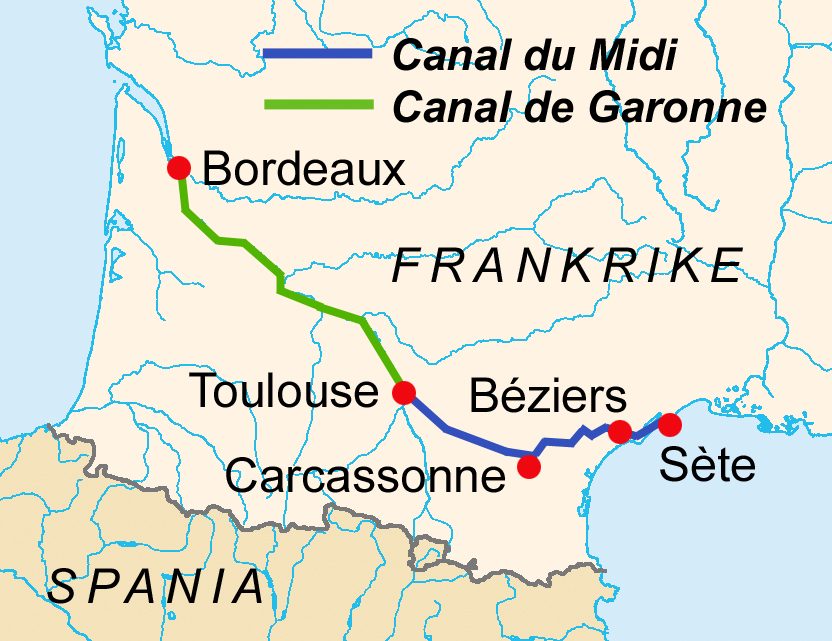
Up to 12,000 workers were needed on this titanic site, wielding shovels and pickaxes to dig the canal. The engineer Riquet came up with the idea of monthly payments, which were exceptional for the time, to retain workers and avoid falling behind.
It also provides unprecedented social rights: sick leave, pay for days off (rain), Sundays and public holidays. The employment contract is individual and is based on open recruitment.
Today, management of the canal is still problematic due to its recurrent silting up, with a lot of alluvial silt clogging up navigation. A maintenance team is on hand all year round to prevent any risk of leakage or breach.
The Canal du Midi, star of tourism
From the 1970s onwards, goods transport stopped on the canal, replaced by river tourism, which was booming with the development of the leisure society. It is now busier than the Seine, with 80% of users from abroad and 10,000 boat passages per year. Ports and locks punctuate the river’s course, offering you a truly cultural journey along the way. All along the canal, you’re offered a path of knowledge lined with magnificent landscapes. In fact, there’s no shortage of engineering structures to be found along the way: locks, bridges and aqueducts.
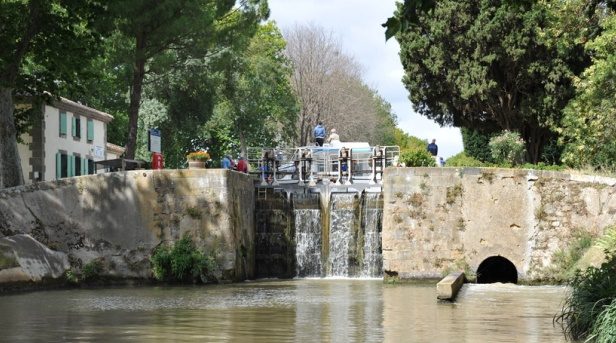
241 km long, the Canal du Midi stretches from Toulouse to the Etang de Thau, crossing the Lauragais region before following the Aude valley from Carcassonne to Ginestas, then on to the Etang de Thau via Béziers and Agde.
The majestic finish is in Narbonne, where you glide under the medieval Pont des Marchands (Merchants’ Bridge) before continuing on through ponds and lagoons to finally reach Port Nouvelle, on the Mediterranean.
The Canal du Midi is home to a wealth of flora and fauna, and the murmur of your boat’s glide will be so gentle that you’ll be able to observe a multitude of animals at your leisure.
Take advantage of your stay at your campsite to enjoy a soothing break near the banks of the Canal du Midi.
Your campsite near Gouffre géant de Cabrespine
Just 31 km from your Martinet Rouge campsite in the Aude, the giant chasm of Cabrespine, a geological wonder, awaits you in the heart of the Montagne Noire. Located above the village of Cabrespine, this is one of the world’s largest caves open to the public. One of Aude’ s must-see attractions!
Graced with impressive dimensions (80 m wide by 250 m deep), it is home to remarkably rich concretions such as the exceptionally large aragonites.
History of the discovery of Cabrespine
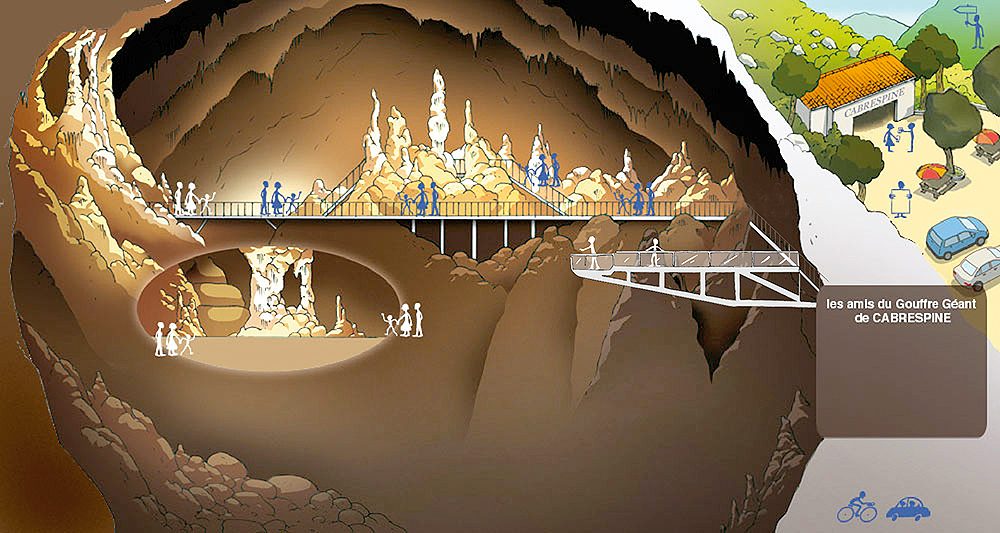
It was discovered relatively recently by amateur speleologists in 1970, although texts refer to it in the 16th century. Excavations have uncovered remains attesting to human occupation of the cave (pottery-tools).
Videos credit SETSN_Dare Pixel
The chasm is linked to the Gaougnas rock shelter – through which the visit opens – known as the “Reboul” hole, already well known to the locals.
It was under Napoleon that this cavity was filled in to allow a road to be built. But the waters of the “Clamoux” river continued to flow and cut a passage through the cave. This will lead to the collapse of the land adjacent to the road at the entrance to the village.
Until its discovery, no one had been able to link the chasm and the Gaougnas cave, although many people suspected that a passage existed.
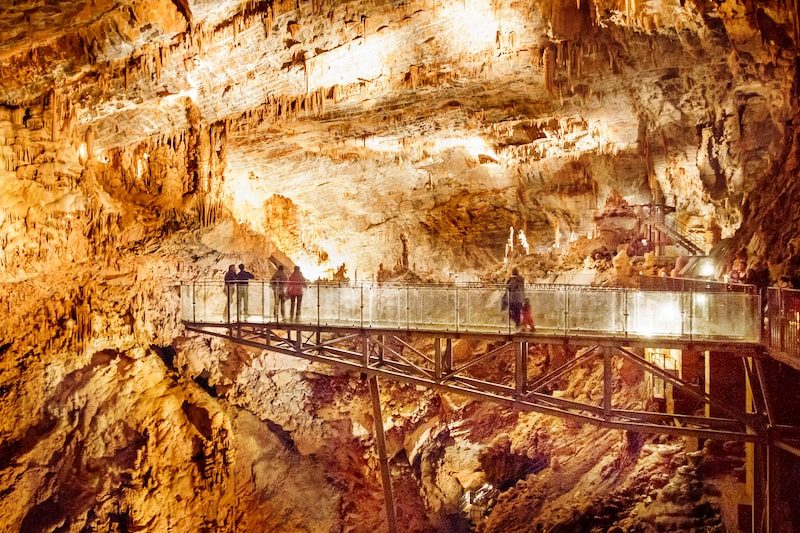
In 1959, two cavers succeeded in making the junction between the Gaougnas and another cavity called the Barrenc, but it was not until ten years later that two other cavers succeeded in forcing the passage and discovered the giant chasm.
This natural treasure trove is renowned for the quality and variety of its concretions: disks, eccentrics, columns, waterfalls, speleothems, draperies, aragonites…The iron and manganese present in the waters that dug the galleries have coloured the concretions bright ochre, which can be seen in the so-called red room.
Visit one of Aude’s most beautiful caves
Don’t hesitate to visit the giant Cabrespine chasm, with its 25 km of galleries, and take part in the underground safaris, discovery tours open to the public that plunge you even deeper into this original world during an expedition lasting around 5 hours. You don’t need any special skills to make this circuit.
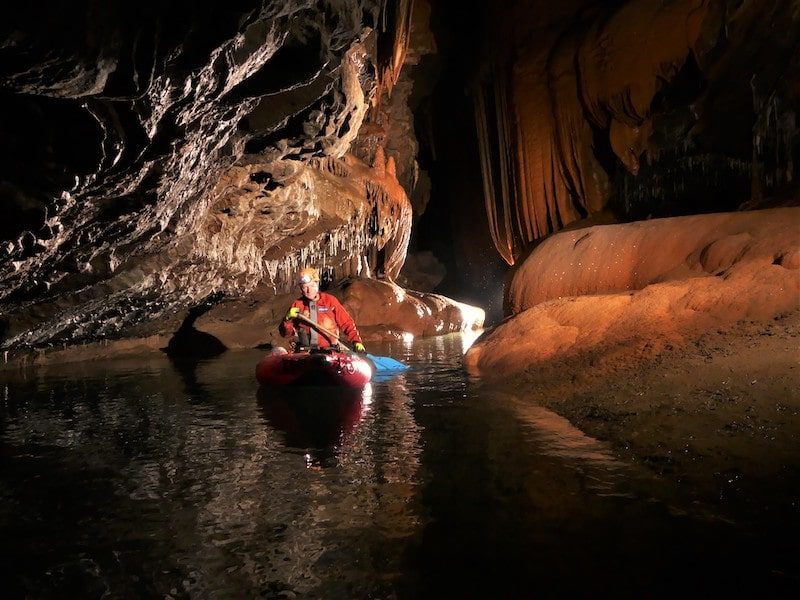
Book your cottage in the heart of nature near Carcassonne or a pitch at camping le Martinet Rouge
INFORMATION
Cabrespine Giant Abyss
11160 Cabrespine
04 68 26 14 22
Accueil
Camping near Cabrespine, camping grotte de cabrespine
Limousis caves
Just 20 kilometers from your campsite, the Limousis cave north of Carcassonne offers a unique visit.
It’s one of a series of concretion caves in the Aude department that have been declared a World Natural Heritage Site.
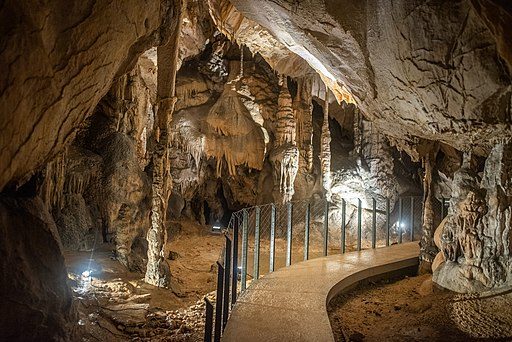
Limousis A refuge since prehistoric times
Thanks to archaeological excavations carried out in conjunction with the development of the cave for visitors, we know that the Limousis cave has been occupied by man since prehistoric times. Unfortunately, at the beginning of the century, the science of archaeology was still in its infancy, and earthworks were carried out without any method, resulting in the loss of many remains. It was the chance visit of Abbé Janard, an amateur archaeologist, that saved some of the pieces from oblivion and demonstrated the interest of the site. It is thanks to these finds that we can confirm that man has occupied this cave from prehistoric times right up to the Middle Ages, finding refuge whenever a threat alerted the local inhabitants, or shelter for those who worked in the area: shepherds, hunters, woodcutters etc…
Limousis From a simple cave to a major site
In 1825, the cave was opened to visitors, under the supervision of a guide, with the entrance fee donated to the commune’s poor by municipal decision.
A lease was then granted to manage the cave and its visitors. The first footbridge was built to access the part of the cave containing the previously inaccessible inner lake. During maintenance work in 1913, the site workers guessed that another gallery lay beyond a stalagmitic wall… He dug down and discovered the famous aragonite chandelier, which was to become the centerpiece of the visit.
It wasn’t until 1935 that visits were conducted by electric light, which significantly increased the number of visits until the discovery of the Cabesprine chasm, which stole the limelight from the Limousis cave.
In 2003, the manager in charge of the cave renovated the site’s electrical system and set up a sound and light show to highlight the aragonite chandelier: it was a success, with visitor numbers soaring to 37,000 a year.
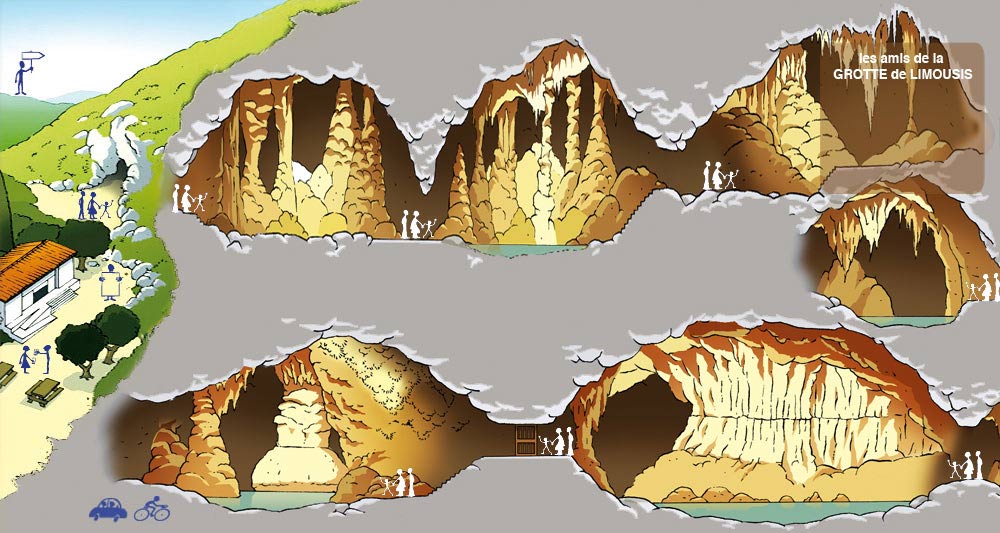
Visit to the Limousis cave
The first room is modest in size, opening onto the much larger “Columns” room further down, which in turn leads to a gallery leading to the “Green Lake” room. Then, in the “ball” room, you’ll discover the first aragonite stones. This hall takes its name from the local tradition of celebrating with music and dance in the cave every year.
Finally, the tour ends in the “lustre” room, the largest and most prestigious of all, featuring the “aragonite lustre”, a concretion measuring several cubic metres and the only one of its kind in the world.
Open daily from March 1 to November 11
www.grotte-de-limousis.com/
To visit this remarkable historical heritage, book your pitch or accommodation at Le Martinet campsite and take advantage of our special offers.
camping Limousis, limousis caves





